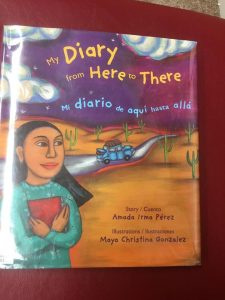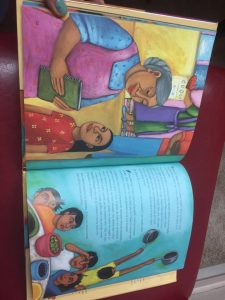

Title: My Diary from Here to There, Mi Diario de Aqui hasta Alla.
Author: Amada Irma Perez
Illustrator: Maya Christina Gonzalez
Publication/ Year: Children’s Book Press, 2002
Number of Pages: 31
Tags/ Themes: Adventure, Culture, Diversity, Emotion, Family, Non-Fiction, Picture Book, Spanish, K-5, Rebecca Cauthorn
Genre: Non-Fiction
Descriptive Annotation: This story follows the journey of the author as a young girl when she moved from Mexico to the United States. It is formatted as diary entries, probably based off of the real diary entries Amada wrote when she was young. This story is great because it shows both the excitement and the worry that people have when they are leaving their home country. A key part of this book is that on every page, there is the text written in both Spanish and in English. This is important because it would be a great tool to use with either bilingual or ESL students. There is an author’s note at the end of the book which describes why this story is important to her and how she wants to encourage people who are new to the United States to be brave, and be true to themselves.
Classroom Application: If I was working with either a bilingual student or an English as a Second Language Learner, this book would be very helpful. By including both the English words and the Spanish words it allows students to try to read the foreign language, while also being able to look and read the comfortable language in case they get stuck, and to figure out the meaning of the words. By having this book in the classroom, it would allow students to feel more comfortable and excited to read, knowing that there are books which accommodate their language needs. But this book is also great for students who only speak English because it shows them that students who come from different countries are just like they are—excited to learn, worried about making friends, and totally human.
Linguistic and Cultural Diversity Analysis: This book does an excellent job portraying the different cultures and the struggle of immigrant families finding a place in a different country. It shows diversity and the strength that people have to be brave and be themselves. The author uses both English and Spanish, which is a key part of this book because it allows it to be accessible for students of any background (assuming they speak either Spanish or English), and the text, while dense, is very honest and relatable. One example of the honest text is seen on page 9, “Mama and Papa keep talking about all the opportunities we’ll have in California. But what if I can’t learn English? Will I ever see Michi again? What if we never come back?” These questions are very real questions many people have when moving to a different place, and some students in the classroom may have even gone through a similar experience which would make this book that much more powerful: they are not alone.
Illustration:
